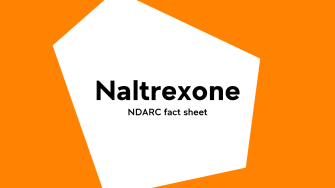3 Jun 2025
NDARC fact sheet:
Naltrexone
Naltrexone

Naltrexone is a prescription opioid antagonist drug that is used to treat opioid dependence. It has no euphoric effect but acts to block the effects of opioids.
Naltrexone is also prescribed for treatment of alcohol dependence by reducing the effects of alcohol on the body and diminishing cravings overtime.
It is taken orally as a tablet, by subcutaneous implants (a pellet or other container inserted under the skin that slowly releases the drug) or by intramuscular injection in a slow-release suspension. Naltrexone is most effective in patients who are highly motivated and who have good social support.
People prescribed naltrexone are less likely to use illicit opioids, or to become involved in the criminal activities associated with illicit drug use.
For those taking naltrexone for alcohol dependence, the medication can reduce the craving for alcohol and reduce the ‘reward’ effects of alcohol use.
The effects of naltrexone may include:
Less common side effects include:
Naltrexone blocks the actions of opioids and rapidly removes a person’s tolerance to opioids. If naltrexone treatment is ceased, individuals may be at risk of overdose if they choose to return to opioid use.
To avoid the risk of initiating acute opioid withdrawal, patients must be opioid-free for at least seven to 10 days before starting naltrexone. In some cases, another opioid antagonist drug called naloxone is administered to ensure a patient does not experience a severe opioid withdrawal reaction when commencing naltrexone. Caution is recommended when using naltrexone if there are signs of liver damage.
The Illicit Drug Reporting System (IDRS) is an Australian monitoring system run by the National Drug and Alcohol Research Centre (NDARC) at UNSW Sydney that identifies emerging trends of local and national concern in illicit drug markets.
The Ecstasy and Related Drugs Reporting System (EDRS) is an Australian monitoring system run by NDARC that identifies emerging trends of local and national interest in ecstasy and related drug use, markets and harms.
The Pocket Guide to Drugs and Health is a publication authored by experts from NDARC that provides information for health professionals on the impact of drug use.
The Australian Institute of Health and Welfare collects information on alcohol and tobacco consumption, and illicit drug use among the general population in Australia.
The Australian Bureau of Statistics is Australia’s national statistical agency, providing official statistics on a range of economic, social, population and environmental matters of importance to Australia.
Alcohol and Drug Foundation (2024). Naltrexone. Retrieved from: adf.org.au/drug-facts/naltrexone/
Gibson, A. and Degenhardt, L. (2005). Mortality related to naltrexone in the treatment of opioid dependence: A comparative analysis. National Drug and Alcohol Research Centre, UNSW. Retrieved from: ndarc.med.unsw.edu.au/resource/mortality-related-naltrexone-treatment-opioid-dependence-comparative-analysis
If you, or someone around you, is experiencing undesired or distressing psychological or physical symptoms from the intake of alcohol or other drugs, please seek immediate medical attention.
If you need urgent help from ambulance services, call Triple Zero (000). If a person has been mixing drugs with alcohol or other drugs, tell the paramedic exactly what has been taken.
For free and confidential advice about alcohol and other drugs, call the National Alcohol and Other Drug Hotline on 1800 250 015. The hotline will automatically direct you to the Alcohol and Drug Information Service in your state or territory.
3 Jun 2025
Fact Sheets
NDARC
Download this resource